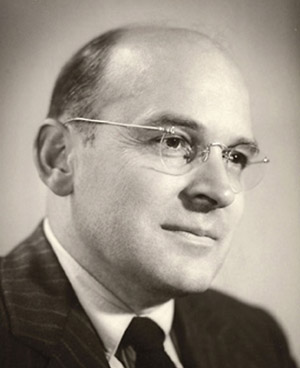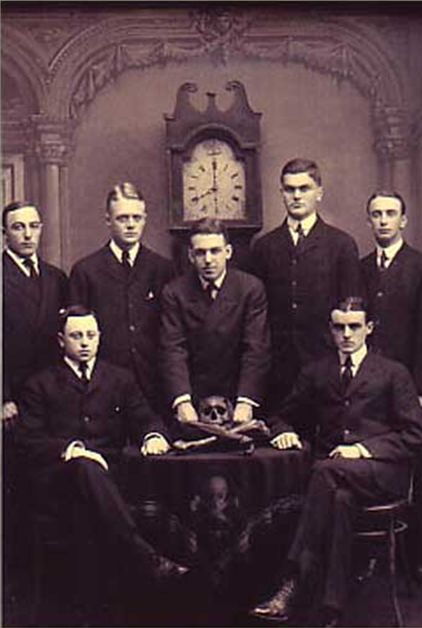F.O. Matthiessen & Russell Cheney

Francis Otto Matthiessen (February 19, 1902 - April 1, 1950) was an educator, scholar and literary critic influential in the fields of American literature and American studies.
Matthiessen had a 20-year romantic relationship with the painter Russell Cheney. The couple shared a cottage in Kittery, Maine for decades. In planning to spend his life with Cheney, Matthiessen went as far as asking his cohort in the Yale secret society Skull and Bones to approve of their partnership (Levin 43-44). With Cheney having encouraged Matthiessen's interest in Whitman, it has been argued that American Renaissance was "the ultimate expression of Matthiessen's love for Cheney and a secret celebration of the gay artist." (Matthiessen and Cheney on a Normandy beach, summer 1925. Cheney’s nickname, Rat, and Matthiessen’s, Devil, came into use at Yale.)
Matthiessen was born in Pasadena, California, where he was a student at Polytechnic School. Following the separation of his parents, he relocated with his mother to his paternal grandparents home in La Salle, Illinois. He completed his secondary education at Hackley School, in Tarrytown, New York. In 1923 he graduated from Yale University, where he was a member of Skull and Bones. In his final year as a Yale undergraduate, Matthiessen received the Alpheus Henry Snow Prize, awarded to the senior who through the combination of intellectual achievement, character and personality, shall be adjudged by the faculty to have done the most for Yale by inspiring in classmates an admiration and love for the best traditions of high scholarship.

Matthiessen and Cheney on a Normandy beach, summer 1925.
Russell Cheney (1881 - 1945) had a twenty-year love affair with English Literature Professor F.O. Matthiessen (1902 - 1950), an authority on American Literature, who taught at Yale and Harvard and who was also a Yale graduate and became a member of Skull & Bones in 1923. Matthiessen was twenty years Russell's junior. Their letter are collected into Rat & the Devil: Journal Letters of F.O. Matthiessen and Russell Cheney. Cheney’s nickname, Rat, and Matthiessen’s, Devil, came into use at Yale.
He studied at Oxford University, as a Rhodes Scholar earning a B.Litt. in 1925. At Harvard University, he quickly completed his M.A. in 1926 and Ph.D. degree in 1927. Matthiessen then returned to Yale to teach for two years, before beginning a distinguished teaching career at Harvard.
Matthiessen was an American studies scholar and literary critic at Harvard University, and chaired its undergraduate program in history and literature. He wrote and edited landmark works of scholarship on T. S. Eliot, Ralph Waldo Emerson, the James family (Alice James, Henry James, Henry James Sr., and William James), Sarah Orne Jewett, Sinclair Lewis, Herman Melville, Henry David Thoreau, and Walt Whitman.
Matthiessen's best-known book, American Renaissance: Art and Expression in the Age of Emerson and Whitman (1941), discusses the flowering of literary culture in the middle of the American 19th century, with Emerson, Thoreau, Melville, Whitman and Nathaniel Hawthorne. Its focus was the period roughly from 1850 to 1855 in which all these writers but Emerson published what would, by Matthiessen's time, come to be thought of as their masterpieces: Melville's Moby-Dick, multiple editions of Whitman's Leaves of Grass, Hawthorne's The Scarlet Letter and The House of the Seven Gables, and Thoreau's Walden. The mid-19th century in American literature is commonly called the American Renaissance because of the influence of this work on later literary history and criticism. In 2009 The New York Times said that the book "virtually created the field of American literature."
Matthiessen's politics were left-wing and socialist, though not dogmatically Marxist, as he felt his Christianity was incompatible with Marxist atheism. Matthiessen, who was already financially secure, donated an inheritance he received in the late 1940s to his friend, Marxist economist Paul Sweezy. Sweezy used the money, totalling almost $15,000, to found a new journal, which became the Monthly Review. Matthiessen was mentioned as an activist in Boston area so-called "Communist front groups" by Herbert Philbrick.
Matthiessen, as a gay man in the 1930s and 1940s, chose to remain in the closet throughout his professional career, if not in his personal life - although traces of homoerotic concern are apparent in his writings. In 2009, a statement from Harvard University said that Matthiessen "stands out as an unusual example of a gay man who lived his sexuality as an 'open secret' in the mid-20th century."
He was hospitalized once for a nervous breakdown in 1938-1939. After Cheney's death in 1945, Matthiessen became increasingly distraught. He committed suicide by jumping from a Boston hotel window in 1950. Inquiries by the House Un-American Activities Committee into his politics may also have been a factor in his suicide. Writing in 1958, Eric Jacobsen referred to Matthiessen's death as "hastened by forces whose activities earned for themselves the sobriquet un-American which they sought so assiduously to fasten on others". In 1978, however, Harry Levin was more skeptical, saying only that "spokesmen for the Communist Party, to which he had never belonged, loudly signalized his suicide as a political gesture".
Matthiessen was buried at Springfield Cemetery in Springfield, Massachusetts.
Matthiessen's contribution to the critical celebration of 19th-century American literature is considered formative and enduring. Along with several other scholars, he is regarded as a contributor to the creation of American studies as a recognized academic discipline. His stature and legacy as a member of the Harvard community has been memorialized in several ways by the university. He was the first Senior Tutor at Eliot House, one of Harvard College's undergraduate residential houses. More than sixty years after his death, his suite at Eliot House remains preserved as the F. O. Matthiessen Room, housing personal manuscripts and 1700 volumes of his library available for scholarly research by permission. In 2009 Harvard established an endowed chair in LGBT studies called the F. O. Matthiessen Visiting Professorship of Gender and Sexuality. Believing the post to be "the first professorship of its kind in the country," Harvard President Drew G. Faust called it “an important milestone.” It is funded by a $1.5 million gift from the members and supporters of the Harvard Gay & Lesbian Caucus.
Source: http://en.wikipedia.org/wiki/F.O._MatthiessenThe cultural system of gender emblematized by the fairy had enormous influence on the way even most queers understood themselves and structured their encounters. Most significantly, the belief that desire for a man was inherently a woman's desire led even many of those queers who regarded themselves as normally masculine in all other respects to regard their homosexual desire as a reflection of a feminine element in their character. In 1925, when F.O. Matthiessen, the noted Harward literary historian and critic, was still a graduate student at Oxford, he wrote to his lover, the painter Russell Cheney, "We are complex - both of us - in that we are neither wholly man, woman, or child." In another letter he noted: "Just as there are energetic active women and sensitive delicate men, so also there are... men, like us, who appear to be masculine but have a female sex element." Matthiessen's self-conception was thus different from that of many fairies, because he distinguished the sexual "element" from other elements of his gender persona and did not believe that the inversion of his sexual desire meant his entire gender character was inverted. Nonetheless, he did believe that his love for Cheney, as the sexological treatises written by Havelock Ellis explained and his grounding in his culture affirmed, must be a "female" love, even if he otherwise appeared to be masculine. --Gay New York: Gender, Urban Culture, and the Making of the Gay Male World, 1890-1940 by George Chauncey

Russell Cheney (October 16, 1881 - July 12 , 1945) was an American painter. He graduated from Yale in 1904, where he was a member of the Skull and Bones secret society.
Born in South Manchester, Connecticut in 1881, he was the grandson of artist John Cheney. Following graduation from Yale in 1904, Cheney studied at the Art Students League in NYC under Chase, Cox, and Woodbury, and was its acting president in 1909-10, and in Paris at Académie Julian. Most of Cheney's career was spent in the East; however, bouts with tuberculosis forced him to seek warmer climates. Active in California from 1916, he often painted in Santa Barbara where his sister lived. He died in Kittery, Maine on July 12, 1945. A gay man, he had a twenty-year love affair with English Literature Professor Francis Matthiessen, an authority on American Literature, who taught at Yale and Harvard Universities and who was also a Yale graduate and became a member of Skull & Bones in 1923. Matthiessen was twenty years Russell's junior.
He held his first New York exhibition in Babcock Galleries 1922. His portrait of Professor Candle hung in the Paris Salon in 1909 and his work has been represented in many museums including the Boston Museum of Fine Arts and the San Francisco Museum of Art. Cheney illustrated F. O. Matthiessen's book Sarah Orne Jewett (1929), on the writer of the same name. A catalogue of Cheney's paintings was published in 1922. Cheney was a member of the Connecticut Academy of Arts and Sciences, Colorado Springs Fine Arts Center, and San Francisco Art Society.

The Jewett House at South Berwick, From a painting by Russell Cheney


Cheney (seated first row on the right) as members of Skull and Bones

Cassis, 1924

Still Life with Flowers, Smithsonian American Art Museum

Meeting House Hill, Portsmouth
Russell's death was due to mesenteric thrombosis. He was buried in East Cemetery in Manchester, Connecticut. He was survived by Matthiessen, two sisters, Ednah Cheney Underhill of Santa Barbara, Calif and Mrs. Halstead Dorey of Boerne, Texas. He had three brothers Knight Dexter Cheney, Philip Cheney, and Thomas Langdon Cheney, who were also members of Skull and Bones.
Burial: East Cemetery, Manchester, Hartford County, Connecticut, USA
Source: http://en.wikipedia.org/wiki/Russell_Cheney

Days of Love: Celebrating LGBT History One Story at a Time by Elisa Rolle
Paperback: 760 pages
Publisher: CreateSpace Independent Publishing Platform; 1 edition (July 1, 2014)
Language: English
ISBN-10: 1500563323
ISBN-13: 978-1500563325
Amazon: Days of Love: Celebrating LGBT History One Story at a Time
Days of Love chronicles more than 700 LGBT couples throughout history, spanning 2000 years from Alexander the Great to the most recent winner of a Lambda Literary Award. Many of the contemporary couples share their stories on how they met and fell in love, as well as photos from when they married or of their families. Included are professional portraits by Robert Giard and Stathis Orphanos, paintings by John Singer Sargent and Giovanni Boldini, and photographs by Frances Benjamin Johnson, Arnold Genthe, and Carl Van Vechten among others. “It's wonderful. Laying it out chronologically is inspired, offering a solid GLBT history. I kept learning things. I love the decision to include couples broken by death. It makes clear how important love is, as well as showing what people have been through. The layout and photos look terrific.” Christopher Bram “I couldn’t resist clicking through every page. I never realized the scope of the book would cover centuries! I know that it will be hugely validating to young, newly-emerging LGBT kids and be reassured that they really can have a secure, respected place in the world as their futures unfold.” Howard Cruse “This international history-and-photo book, featuring 100s of detailed bios of some of the most forward-moving gay persons in history, is sure to be one of those bestsellers that gay folk will enjoy for years to come as reference and research that is filled with facts and fun.” Jack Fritscher
This journal is friends only. This entry was originally posted at http://reviews-and-ramblings.dreamwidth.org/2887718.html. If you are not friends on this journal, Please comment there using OpenID.